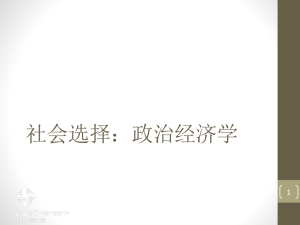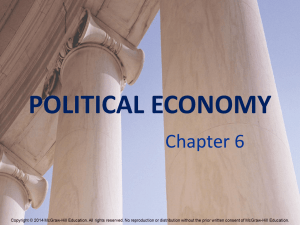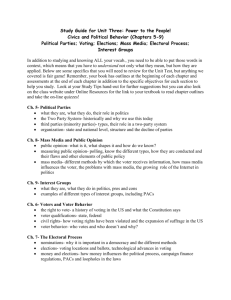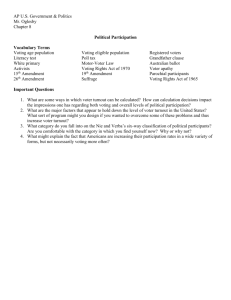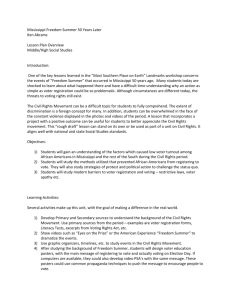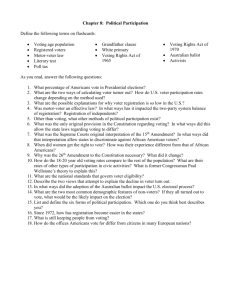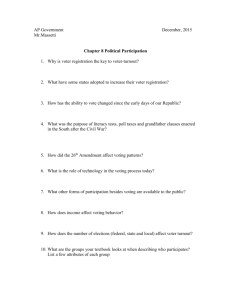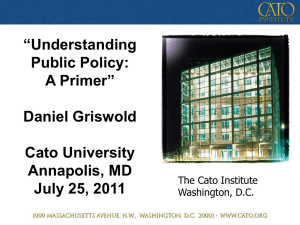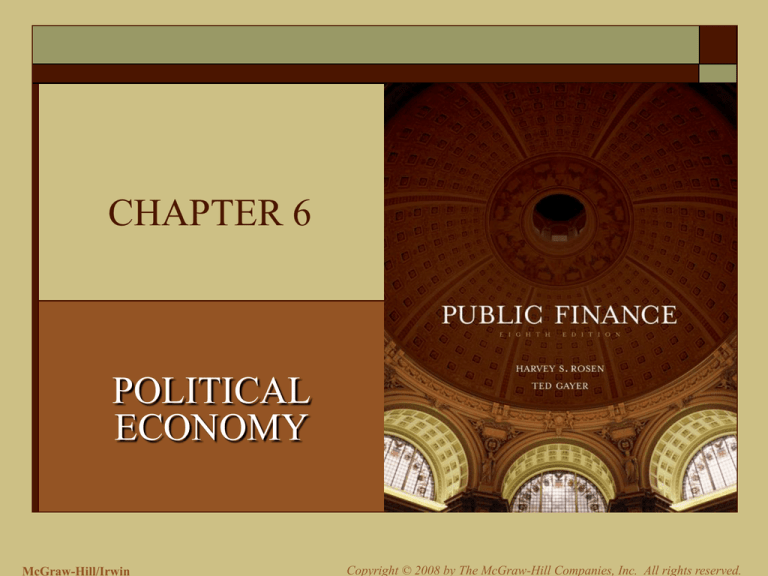
CHAPTER 6
POLITICAL
ECONOMY
McGraw-Hill/Irwin
Copyright © 2008 by The McGraw-Hill Companies, Inc. All rights reserved.
Political Economy
Public decision making in public finance is
complicated and not well understood.
Contrary to simple models of democracy,
there appear to be forces pulling government
expenditure away from levels that would
preferred by the median voter.
However, critics of the budgetary process
have not come up with a satisfactory
alternatives.
6-2
Political Economy
The formulation of meaningful rules and constraints
for the budgetary process, either at the constitutional
or statutory level, is an important item on both the
academic and political agendas for the years ahead.
It should be stressed that a judgment that the current
system of public finance is inequitable or inefficient
does not necessarily imply the government as an
institution is “bad.”
People who like market-oriented approaches to
resource allocation can nevertheless see to improve
markets. The same goes for government.
6-3
Political Economy
Public finance in any state aims at redistributing the
incomes in an ethically, desirable way. But can it do
that???
Political economy determines this redistribution
process of incomes taking into consideration
selfishness and fairness principles.
Political economy is the product of direct democracy.
A procedure designed to elicit unanimous agreement
was proposed in the early 20th century by Lindahl.
6-4
Lindahl Model
An obvious similarity exists between the role
of tax shares in the Lindahl model and market
prices in the usual theory of demand.
But there is an important difference. Instead of
each individual facing the same price, each
faces a personalized price per unit of public
good, which depends on his or her tax share.
The tax shares are preferred to as Lindahl
prices.
6-5
Eve’s share (SE)
Direct Democracy-Unanimity Rules
0’
DrE
Adam’s share (SA)
S*
DrA
0
r per year
r*
The Lindahl Model
6-6
Feasibility of Unanimity Rules
Reaching equilibrium
Lindahl Model has two practical problems
1.
Strategic behavior: sincere decision might not be
taken by everyone
2.
Time to reach equilibrium through election or
referendum.
6-7
Direct Democracy-Majority Voting Rules
Majority voting rule – one
more than half of the voters
must favor a measure for it
to be approved.
Majority decisions rules do
not always yield such
clear-cut results leading to
voting paradox which
refers to that fact that
voter’s preferences are
consistent while the
community’s are not.
Voter
Choice
Brad
Jen
Angelina
First
A
C
B
Second
B
B
C
Third
C
A
A
6-8
Direct Democracy-Majority Voting Rules
1.
2.
3.
Problems of Direct DemocracyMajority Voting Rules:
Voting Paradox – community
preferences can be inconsistent
even though individual’s
preferences are consistent.
Agenda Manipulation – process
of organizing order of votes to
ensure a favorable outcome.
Voter
Choice
Brad
Jen
Angelina
First
A
C
B
Second
B
A
C
Third
C
B
A
Cycling – when paired voting on
more than two possibilities goes
on indefinitely without a
conclusion ever being reached.
6-9
Graphing Preferences
Utility
Single-peaked preferences
Jen
Double-peaked preferences
Brad
Angelina
A
B
C
Missiles
6-10
Practical Importance of Double-peaked
Preferences
If all voters’ preferences are single peaked,
not voting paradox occurs.
But in fact, voters’ preferences are doublepeaked or more.
Availability of private substitutes
Majority voting may lead to inconsistent
decisions regarding the public goods if some
people’s preferences are not single peaked.
6-11
The Median Voter
Median voter happens when the voter whose
preferences lie in the middle of the set of all voter’s
preferences; half the voters want more of the good
than the median voter, and half want less.
The median voter theorem states that as long as all
preferences are single peaked, the outcome of
majority voting reflects the preferences of the
median voter.
But remember, there might be two median voters,
which must be broken arbitrary.
6-12
Direct Democracy - The Median Voter Theorem
Voter
Expenditure
Donald
$5
Daisy
100
Huey
150
Dewey
160
Louie
700
6-13
Logrolling
Logrolling systems allow people to trade
votes and hence register how strongly they
feel about various issues.
However, minority gains may come at the
expense of the greater general losses.
6-14
Direct Democracy - Logrolling I
Voter
Project
Melanie
Rhett
Scarlet
Hospital
200
-50
-55
Total Net
Benefits
95
Library
-40
150
-30
80
Pool
-120
-60
400
220
6-15
Direct Democracy - Logrolling II
Voter
Project
Melanie
Rhett
Scarlet
Hospital
200
-110
-105
Total Net
Benefits
-15
Library
-40
150
-120
-10
Pool
-270
-140
400
-10
6-16
Direct Democracy - Arrow’s Impossibility Theorem
Arrow’s Impossibility Theorem states that, in general, it
is impossible t find a decision making rule that
simultaneously satisfies a number of apparently
reasonable criteria.
The implication is that democracies are inherently prone
to make inconsistent decisions.
Nobel Laureate Kenneth Arrow proposed that in a
democratic society, a collective decision-making rule
should satisfy various criteria.
6-17
Reasonable Criteria of Nobel Laureate Kenneth Arrow
1.
2.
3.
4.
5.
6.
Nobel Laureate Kenneth Arrow proposed that in a
democratic society, a collective decision-making rule
should satisfy various criteria.
Producing a decision whatever the configuration of
voters’ preferences.
Ranking all possible outcomes.
Being responsive to individual preferences.
Being consistent to all individual preferences.
Being independence of irrelevant alternatives.
Not reflecting the preferences of only single individual.
6-18
Direct Democracy - Arrow’s Impossibility Theorem
“Reasonable” collective decision-making
criteria
It can produce a decision whatever the
configuration of voters' preferences
It must be able to rank all possible
outcomes
It must be responsive to individuals’
preferences
It must be consistent
Independence of irrelevant alternatives
Dictatorship ruled out
Arrow’s Impossibility Theorem
Meaning of theorem
consistent rule not necessarily impossible to
find, but cannot be guaranteed
Buchanan’s critique
All conceivable voting schemes have some
potential for being unfair or producing a
paradoxical result
Inconsistencies of majority voting have
beneficial aspects. P#116.
Use of social welfare functions must be chosen
collectively. Economists argue that the Arrow
is merely a way of introducing value
judgments and not representation of society’s
preferences.
6-19
Representative Democracy - Elected
Politicians
Explanations of government behavior require studying
the interaction of elected officials, public employees, and
special interest groups.
Under the restrictive assumptions, the actions of elected
officials mimic the wishes of the median voter.
6-20
Representative Democracy - Elected
Politicians
Number of Voters
Liberal
Conservative
6-21
Implications of the Median Voter Model
Two-party systems tend to be stable
Replacement of direct referenda by
representative system has no effect on
outcomes. Both simply mirror the preferences
of the median voter.
Thus government spending cannot be
“excessive” because politicians competition
for votes leads to an expenditure level which
is exactly in accord with median voter’s
wishes.
6-22
Other Factors Influencing Voting
1.
2.
3.
4.
5.
Single-dimensional rankings: If all political
beliefs cannot be ranked along a single
spectrum, the median voter theorem falls
apart because the identity of the median voter
depends on the issue being considered.
Ideology
Personality
Leadership
Decision to vote
6-23
Representative Democracy-Public Employees
Function of bureaucrats
Goals of bureaucrats
6-24
Niskanen’s Model of Bureaucracy
C
$
V
Actual
output
Efficient
output
0
Q*
Qbc
Q per year
6-25
Representative Democracy – Special Interests
What are “Special Interests”
Establishment of Special Interest Groups
Source of Income: Capital or Labor
Size of Income: Rich and poor.
Source of Income: Industry of Employment
Region: Midwesterners favor agricultural subsidies while
northeasterners favor the expenditure of urban
development
Demographic and Personal Characteristics: The elderly
favor health care while young favor good schools and
lower payroll taxes.
6-26
Representative Democracy – Rent-Seeking
$
Rents
S=MC
D
tons of peanuts per year
MR
6-27
Representative Democracy – Other Actors
Judiciary: Court decisions on the legality of
various taxes can affect public finance.
Journalists: They can bring certain issues to
public attention which in turn gives press
considerable influence.
Experts: Information is an important source of
power. Legislation aides who gain expertise
on certain programs often play important roles
in drafting statues.
6-28
Explaining Government Growth
Citizen Preferences
Median voter’s demand of public good & services (G) is some function (f)
of the relative price of public sector goods and services (P) and
income (I).
G = f(P, I)
Marxist View: The private sector tends to overproduce, so the capitalistcontrolled government must expand expenditure to absorb this production.
Chance Events: This includes wars and economic crisis. For example, the
financial assistance given by the various government to save the crumbled
business after the global financial crisis.
Changes in Social Attitudes: Increasing demand ignoring the cost of
public programs.
Income Redistribution: The low income voters push governments to
redistribute incomes towards them. To attract this category of voters,
government find no way but to increase its expenditure.
6-29
Controlling Government Growth
Government growth as a non-issue
Government growth as a problem
Commitments made in the past
Basic flaws in the political system
6-30
Improving the Workings of the Political
System
Change bureaucratic incentives
financial incentives
privatization
Change Fiscal Institutions
Budget Enforcement Act (BEA) – 1990
Balanced budget rules at the state level
Institute Constitutional Limitations
Balanced budget amendment
6-31
Provisions of a Typical Balanced Budget
Amendment
1.
Congress must adopt a budget statement “in which
total outlays are no greater than total receipts.”
2.
Total receipts may not increase “by a rate greater
than the rate of increase in national income.”
3.
4.
“The Congress and President shall…ensure that
actual outlays do not exceed the outlays set forth in
the budget statement.”
The provisions can be overridden in times of war.
6-32
Critique of Balanced Budget Amendments
Forecasting issues
Definitional issues
Penalties for violation of the law
Economic issues
6-33

